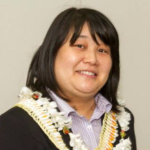Tell us who you think is an Inspirational Leader from this conference. Select a name from the list below and tell us why. Nominees need at least two nominations to be considered.
[badgeos_nomination achievement_id=”1655″]Category Archives: Uncategorized
Pau Hana “After Work” Hour
Session Description
Presenter(s)
 Jamie Sickel
Jamie Sickel
Instructional Designer
Kapi‘olani Community College
Dr. Jamie Sickel is a former teacher educator and current instructional designer for the Center of Excellence for Learning, Teaching, and Technology at Kapi‘olani Community College.
 Youxin Zhang
Youxin Zhang
Instructional Designer
Kapi‘olani Community College
Youxin Zhang works as an instructional designer at Kapiʻolani Community College. She provides pedagogical and technical support to faculty and staff regarding instructional design, professional development, use of technology, and etc.
Foundations of Culinary
Session Description
Foundations of Culinary is a mini online course targeted toward 9th-grade high school students in a specific Career and Technical Education (CTE) pathway. The researchers intended this mini online course to be implemented during the first quarter of a CTE elective class, focusing on career preparation and employability skills to give students real-world experiences related to the restaurant and foodservice industry.
The researchers conducted empathy exercises to understand students' wants and expectations from this subject matter through interviews, which played an important role in the development of the course.
The researchers developed five main modules on Google Classroom to provide students with the base knowledge and skills for culinary arts. Topics include food safety basics, kitchen equipment, standardized recipes, and mise en place. The course ends with the fifth module, where students reflect and present a completed recipe.
Presenter(s)
 Michelle Gima
Michelle Gima
Learning Design and Technology
University of Hawaii at Manoa
I was born and raised in Maui, Hawaii. After earning a Bachelor of Science in Applied Business and Information Technology from the University of Hawaii Maui College, I started teaching various Career and Technical Education classes at my high school alma mater on Maui. During my first year teaching, I earned my teaching licensure from Leeward Community College’s Alternative Certification for CTE Licensure program. I am currently a second-year graduate student at the University of Hawaii at Manoa Learning Design and Technology online program.
 Jesse Joseph
Jesse Joseph
Learning Design and Technology
University of Hawaii at Manoa
Hello, my name is Jesse Joseph. I am a program coordinator for the TRIO Upward Bound
program at the University of Hawaii Maui College. I attended the University of Hawaii at Manoa where I received my Bachelors of Arts before moving on to the master’s program at the Department of Learning Design and Technology. My passion for education stemmed from my work with students from disadvantaged backgrounds while working within the TRIO programs. I believe very strongly in making education accessible to all audiences both in-person and online. I hope to continue the work I started while within this program to improve the lives of students in Maui County.
Session Time
How Do Silicon Valley Tech Companies Do It? A Learning Assessment of a Sexual Harassment E-learning for the workplace.
Session Description
Silicon Valley technology companies advertise innovative technologies as solutions to complex problems, such as training to workplace sexual harassment. Research has shown that amongst healthcare professionals and educators, the use of scenario-based activities in workplace sexual harassment e-learning leads to increased learner awareness and training effectiveness. However, little is known about the impact of workplace sexual harassment e-learning for Silicon Valley technology companies. Therefore, this project aims to evaluate how scenario-based e-learning about workplace sexual harassment training impacts Silicon Valley technology companies. Based on a review of literature, an e-learning was designed and distributed to managers working for a Silicon Valley technology company to measure changes in the cognitive and affective domains of learning. Analysis of the responses from 28 managers demonstrated that increased awareness and confidence is positively associated with the use of scenario-based activities. The results indicate that the use of scenario-based activities in workplace sexual harassment training does have an impact on managers working for a Silicon Valley technology company. More specifically, short-term awareness of sexual harassment increased, ability to identify and react to behaviors of sexual harassment also increased, and confidence in creating a safe work environment also increased. On this basis, it is recommended that Silicon Valley technology companies use scenario-based activities when training managers to workplace sexual harassment e-learning. Recommendations for future research include evaluating the e-learning with a larger sample size and measuring the long-term impact of using scenario-based activities when training to workplace sexual harassment.
Presenter(s)
 Byron Pulu
Byron Pulu
Education Department/ LTEC
University of Hawai'i at Manoa
Aloha, my name is Byron Pulu, and I am a Graduate Student at the University of Hawaii at Manoa, studying Learning Design and Technology. Professionally, I've spent the last ten years working in Silicon Valley as a Learning and Development professional for technology companies like Tesla, Googles/J&J's Verb Surgical, and now TDK U.S.A. Corporation. Developing emotional intelligence in a virtual setting is imperative because a large chunk of our lives are online. And while conducting business, school, and virtual realities online has some significant differences in face-to-face interactions, our attitudes and emotions play a significant role in determining success. As a Manager leading a global team during the covid pandemic, I've had the opportunity to practice developing my emotional intelligence in a virtual setting and coach my team as they embark on their journeys. I am also a coach by nature, professionally working in Human Resources and personally while playing volleyball and hula dancing. My hope for this class is to learn together, grow together, and become more emotionally intelligent human beings.
I look forward to meeting you all.
But Did You Die? Developing Critical Thinking in Paramedics Using Interactive Branching Scenarios
Session Description
The purpose of this project was to design and evaluate scenario-based instruction aimed at improving paramedics’ medical assessment skills. Aimed at emergency medical technicians, the project used Keller's ARCS Model, Gagne's Nine Events of Instruction, and the basics of effective game design, to design instruction that presented various medical scenarios within an online platform. The goal of the instruction was to improve the technicians’ critical thinking and decision-making skills. To evaluate the instruction, 12 (n = 12) emergency medical technicians participated in a study involving the instruction. As participants interacted with the online instruction, data related to the timing and accuracy of their performance were recorded. In addition, open-ended surveys were used to collect qualitative data with regards to the instruction. Results found participants exhibited increased speed and prioritization of questioning per scenario as a result of the instruction. Participants also exhibited increased accuracy in prehospital diagnoses and justification of those diagnoses. While participant surveys regarded the instruction as engaging, they indicated that the interactivity of the instruction played a more critical role. This presentation will examine the study’s findings in detail and explore possible explanations for training emergency medical technicians. Further study is needed to better understand how problem-based learning using interactive branching scenarios may be beneficial in medical education.
Presenter(s)
- Judy Kakazu, Learning Design and Technology, University of Hawaii at Manoa, Honolulu, HI
Session Time
A Usability Study: Empowering Faculty with Tools for Student Engagement in Online Classes
Session Description
According to the faculty survey conducted by the University of Hawaiʻi’s Mānoa Distance Learning Committee (MDLC) in April, 2020, online student engagement, training, and time constraints were among the top concerns for faculty when they moved online in the Spring of 2020 due to the spread of the Covid-19 virus. Those concerns resulted in the design and development of my website whose purpose was to provide faculty with tools for engaging students in online classes and to introduce faculty to microlearning as a learning and training strategy for professional development.
The focus of my Master’s project is on a usability study of my website which consists of microlearning video tutorials designed to train faculty on applications that can increase student engagement in online classes. The Cognitive Theory of Multimedia Learning, the Cognitive Load Theory, and Microlearning on-demand are the backbone of this study putting emphasis on smaller content to ease cognitive overload and increase retention with the use of sounds and imagery. Three iterations of usability testing were remotely conducted on my website using four faculty participants for each one. By the end of the third iteration, the User Success Rate was 100%, faculty walked away with a new tool for student engagement, and the majority selected microlearning video tutorials as their first choice for professional development. Technology doesn’t just support the way students learn, it enhances the way faculty learn as well. Faculty is ready for microlearning, on-demand, video tutorials at UH-Mānoa. Let’s meet their needs.
Presenter(s)
- Ilisa Kea, Learning Design and Technology, University of Hawaiʻi at Mānoa, Honolulu, HI
Learning about online geometry resources
Session Description
This is a usability study on a website that introduces two online geometry resources to geometry teachers at President William McKinley High School. The website introduces Desmos and Geogebra and contains videos on how to use the graphing calculators and class activities. It also has a page where it lists out available activities separated by quarters and modules that follow our DOE State booklet.
Thirteen participants were recruited from teachers at McKinley High School. They were observed heavily on level of interest on the contents and the ease of navigation. There were three iterations, each followed by a revision of the website based on feedbacks from participants.
Presenter(s)
 Shuko Matsubara
Shuko Matsubara
Learning Design and Technology
UH Manoa, Honolulu, HI
Hello, my name is Shuko Matsubara and I graduated from UH Manoa in 2018 with a Bachelor's Degree in Secondary Ed. in Math and Minor in Japanese. I am currently trying to earn my Master's degree in the LTEC program; Learning Design and Technology.
This is currently my third year teaching at President William McKinley High School and I have taught Algebra 1, Algebra 2, Geometry, and AP Calculus.
Evaluating a Mobile-based Genetics Learning Platform in K-12 Educators Teaching After-School Programs
Session Description
In the 2020s, there is no doubt that teaching computer science to K-12 students is beneficial for their future. Similarly, teaching genetics will soon take the spotlight as we move towards a future where humans can sequence and design DNA.
The project is a usability study which includes the prototyping and evaluation of a mobile-based genetics learning platform designed for K-12 students and educators. The target audience for this study were educators teaching any after-school program. In the development phase, a mobile-based application was developed using the integrated development environment Xcode. The content of the application includes lessons inspired from a NC-State-University middle-school curriculum, mini-learning games, and open-source educational videos. The purpose of this study was to evaluate the user-friendliness of the developed mobile-platform. In the evaluation stage, individual usability tests of the mobile-based app were conducted with each selected volunteer. A total of fourteen educators teaching after-school programs to K-12 students participated. Educators were asked to sign a consent form. A pre-survey was administered after each educator was cleared to participate. During the usability test, each subject was asked to complete specific tasks on the mobile-based app to evaluate the app’s user-friendliness. Participants filled out a post-task survey afterwards. Screen user-activity and audio was recorded for consequent data analysis.
The lessons learned from this study indicate that teachers appreciated the simplicity of the mobile-app and colorful design. Future studies will explore the option of allowing more personalization of the app by the users.
Presenter(s)
Saul Bernal Ramos
Learning Design and Technology
University of Hawaii at Manoa
Saul is passionate about education, technology, and science. His master’s degree project is designed to introduce people to the central dogma of biology, “DNA makes RNA, and RNA makes protein". He plans to publish the platform he created after graduating.
Where’s My Pineapple? The Usability of a Website for a Hospitality & Tourism Program
Session Description
The Hospitality and Tourism Education program at Kapiolani Community College does not have a dedicated website to provide students more information about the program. To address this need, this project designed and evaluated a website to welcome and further familiarize new students to the program. The aim of the website was to help students understand the major they have declared and feel comfortable proceeding along their new academic pathway. The website was designed using the ADDIE model in conjunction with the ARCS model of motivation. Technically, Ninjamock was used to create a wireframe of the website and Wix was used to build the actual site which included images and videos to attract attention and entice motivation. In terms of evaluation, 15 (n = 15) adult students participated in a usability test conducted over video conferencing software. Using the methods explained in Krug (2009), the usability test involved three iterations of testing and re-design. Feedback from the testing was generally positive as participants felt the website was easily navigable, contained satisfying content which made them feel welcomed, and interested them in the program. Overall, the project was a success; however, there were some aspects of the project that could be improved. This presentation will review the results of the usability in full and discuss the implications or designing informational websites for students.
Presenter(s)
 Julie Takeda
Julie Takeda
Learning Design and Technology
University of Hawaii at Manoa
Julie grew up in San Jose, California and currently resides in Honolulu, Hawaii. She holds a Bachelor in Arts degree in Japanese Language from the University of Hawai'i at Mānoa. While working as a secretary for the Hospitality and Tourism Education Department at Kapi'olani Community College, she is a LTEC master’s student in her final year at University of Hawaiʻi at Mānoa.
Statistical Literacy for Educators: Usability Study
Session Description
Educators, and especially teachers are among those who collect data from their students and would benefit from understanding of basic principles of Statistics. The purpose of this project was to develop and evaluate an online based resource where basic statistical concepts are paralleled with scenarios of their use in a classroom. The usability study explored ease of use of the website and satisfaction rate of the content presented on the website. The systematic design of instruction and ARCS model were employed during the development of an instructional resource. The website was developed using WIX platform. After that three rounds of usability tests (5–5–2, 12 overall) were conducted. Each session included a pre-survey, cognitive walk-through and a post-survey.
Representatives of the target audience declared for the resource as well as subject matter experts took part in the study, both providing valuable insights about possible ways to improve the user’s experience as well as quality of the content. Overall, there was agreement about simplicity and clearness of the layout, and accessibility of the content. The organization of the content was questioned by some of the participants but generally worked well for the majority of them. Based on the results of the usability study the investigator implemented some changes unifying links and underlined texts. The content of the website met the investigators expectations and demonstrated a high satisfaction rate of the participants. Some major changes suggested throughout the study were accepted, but stayed to be addressed in further iterations of the project.
Presenter(s)
 Dmitrii Egorov
Dmitrii Egorov
Learning Design and Technology (LTEC)
University of Hawaii at Manoa
My name is Dmitrii Egorov and I am a 2018 LTEC Master student. My background includes a Master's degree and doctoral degree in Russian grammar. I taught Russian as a foreign language for 5 years and worked on different projects in linguistics while still in Russia. I moved to Hawaii in early 2017 and just started my new life and career here. Today I work with blended learning and micro-learning projects for Russian learning programs at the Language Flagship Technology Innovation Center at the University of Hawaii at Manoa.
